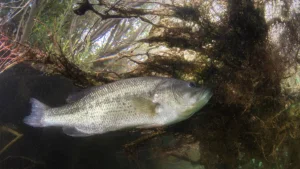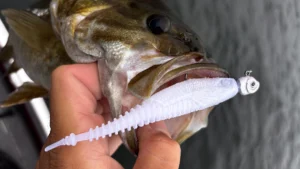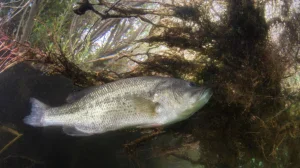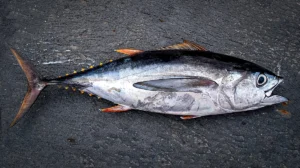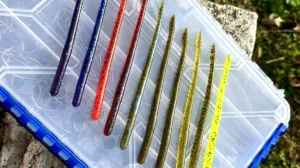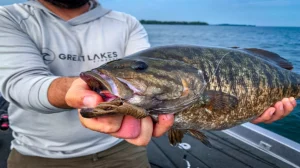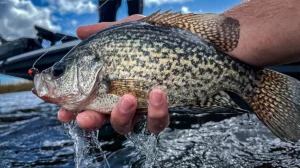There are a few bass fishing bait categories out there that have a little bit of crossover. A shaky head and Texas rig come to mind as both are bottom-contact presentations and both can be rigged with a lot of the same soft plastics. But the two have subtle differences that set them apart and make them better suited for different applications. The same is the case for the two baits we’ll be talking about today: a popper and a popping frog. Both are topwater bass fishing lures, both are similar in size and both create a popping action as they’re twitched along the surface. Their similarities mean there are some scenarios in which they can be used interchangeably. There are also key differences in the two baits, however, that make one far superior to the other given certain scenarios. So today, we’re going to compare and contrast a popper with a popping frog to hopefully help you make the best decision the next time you’re digging through your tackle box and scratching your head while deciding which of these to choose.

Open water
While both a popping frog and a popper work well in open water, I’d recommend one over the other given certain scenarios. For starters, the popper is better when trying to mimic shad and especially when fish are rolling on a bait and not really eating it. The dangling treble hooks that hang from the bottom of a popper give you a far better chance of hooking up with a fish that’s simply swiping at a bait versus the tucked-in, tight weedless hooks of a popping frog.
That being said, I don’t always suggest a popper for open water. There are certain scenarios, like when fishing for big fish in particular, that I’ll lean towards a popping frog in open water over a popper. The reason is that a popping frog has two bold, strong hooks that won’t hardly bend. Whereas the thin-wire treble hooks on a popper are more prone to opening up. So if I’m fishing a mayfly hatch for instance and I’m expecting a big bite, I’ll go with the popping frog which I can fish on heavier gear and trust that the hooks won’t bend; even though I’m fishing in open water and a popper would technically work well, too.

Cover and skipping
On the flip side, it’s almost always best to go with a popping frog over a popper when fishing around cover. This is for the very obvious reason that a popping frog is far more weedless than a popper, which again has two treble hooks dangling down off of it. So when fishing around laydowns, in lily pads or through grass, a popping frog just does a better job of coming through the cover cleanly and makes for a more effective bait choice.
I also give the nod to the popping frog if I’m wanting to skip a bait under cover. Overhanging trees and docks create great cover for a popping-style topwater that mimics either a feeding or injured baitfish along the surface. Although a popper can be skipped a short distance with a lot of practice, a popping frog is far easier to skip further with less practice and it’s less likely to cause a catastrophe if it takes a wild hop up and into the dock or bush.

Spawning baitfish
A popping-style topwater works really well around both shad spawns and bluegill beds, though typically I’d lean towards the popper for both; shad spawn early in the morning along all sorts of cover near the water’s surface. Walking and popping a small popper through a shad spawn makes for a great way to catch these bass. While they will hit a frog too, especially if the fish are super aggressive and buried in cover, typically the popper works best and gives you a better chance of catching any of those fish that just swipe at the bait, which tends to happen as a shad spawn dies down later in the morning.
Bluegill beds are also great for targeting fish with popping-style topwaters and the good thing about this bite is that it can last all day. Unlike the shad spawn that usually only lasts for a short time in the morning, bluegill and other bream are locked in on beds and susceptible to an aggressive bass all throughout the day. So throwing a popper or popping frog into an area where you can see bluegill beds is a great way to draw a big strike. When choosing which to go with here, it really all comes down to cover again.
Bream and bluegill usually bed out in the open, but if they are spawning in sparse cover, the frog gives you the more weedless and less hazardous option. If the beds are out in the open though, it’s hard not to go with the popper. This is again because of the treble hooks, which give you a better chance to hookup with a fish if it simply swipes at the lure.

Line selection
The line I use for these two baits depends on the given situation. Both monofilament and braided line float, so technically both baits could be used on both types of line. But realistically, I’d never recommend throwing a popping frog on anything but braid, the standard being 40-pound test for me. Reason being, throwing a popping frog over into a patch of lily pads with 20-pound mono is simply setting yourself up for heartbreak. If you do get a bite, you’re not likely to get the fish out of the cover without breaking your line. But with braid, the line is capable of cutting through the vegetation and hauling the fish out of the cover.
With poppers, I’ll sometimes use braid and sometimes use monofilament. The deciding factor on this for me is typically how far I’m casting. If I’m fishing close to the boat, say targeting fish around a bluegill bed or a mayfly hatch, I’ll go with 20-pound monofilament because the line stretches and is more forgiving on bites close to the boat, where braided line might simply rip though a fish or even bend the hooks out. But if I’m wanting to make long casts with a popper, I’ll go with 30-pound braid because it’s easier to cast farther and hook up with a fish at a greater distance. But if I do this, I have to remember to back off the drag as a fish nears the boat to again not run the risk of tearing the hooks out or bending them.

In conclusion
While both a popper and a popping frog work well in some of the same scenarios, there’s almost always one option that’s better than the other. General rule of thumb, when fishing around cover go with the frog and when fishing open water stick with a popper. As we just discussed, however, those two aren’t hard-and-fast rules.
Don’t be afraid to go against the grain and use a popping frog in open water if you know you’re fishing for big fish that are aggressive. Then make sure you’re picking the right line for whatever the particular situation and you’ll find that in time, the subtle differences between these two presentations will become clearer and hopefully that’ll lead to you catching more fish!


